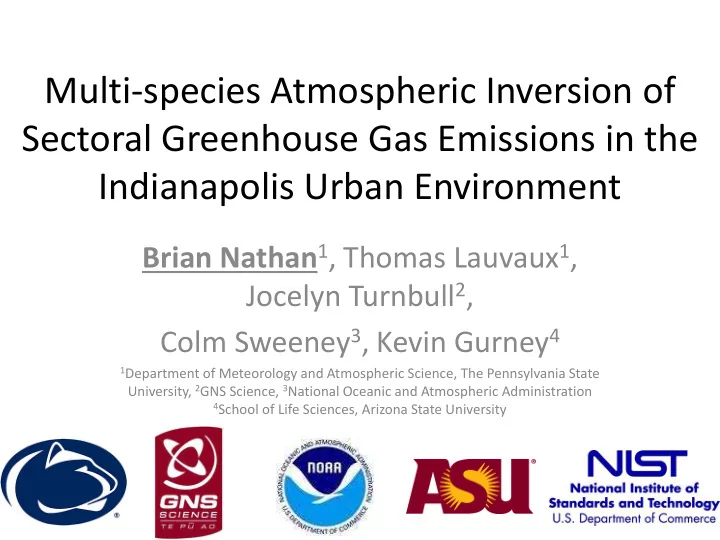

Multi-species Atmospheric Inversion of Sectoral Greenhouse Gas Emissions in the Indianapolis Urban Environment Brian Nathan 1 , Thomas Lauvaux 1 , Jocelyn Turnbull 2 , Colm Sweeney 3 , Kevin Gurney 4 1 Department of Meteorology and Atmospheric Science, The Pennsylvania State University, 2 GNS Science, 3 National Oceanic and Atmospheric Administration 4 School of Life Sciences, Arizona State University
Urban Greenhouse Gas Quantification • 2 Main Objectives: – How much is being emitted – How these emissions are changing over time
Atmospheric Inversion Atmospheric Data Optimized Inversion Emissions Prior Emissions
Sectoral Problem • Policymakers want CO 2 ff emissions information from different economic sectors • Multi-species measurements may be a solution if some species are found to be unique tracers to source sectors HFC-134a CO 2 ff CO
Previous Approaches • Some (like Newman et al. (2016)) have used isotopes to distinguish source signals Newman et al., (2016)
INFLUX Project 6
Hestia CO 2 ff Sectors for Indianapolis OnRoad Lauvaux et al., (2016)
Trace Gas Relationships to CO 2 ff Sectors Much Information More Information Some Information No Expected Emissions Not Fully Researched Nathan et al., (In Revision, 2017) • Very few trace gases are fully quantified
First Strategy: Data Mining Approach
Domain Filling Problem With Sector Prior Info Without Sector Prior Info OnRoad Tracer All Residential Tracers Tracer Nathan et al., (In Revision, 2017)
Is Direct Tracer/Sector Attribution Possible? Nathan et al., (In Revision, 2017)
Footprint/Sector Overlap Limitation = Sector Mask Pixel = Footprint Overlap Pixel
Preliminary Conclusions • Many species have complex relationships with the inventory-defined CO 2 ff sectors • Gas-to-sector ratios are critical, else direct attribution is impossible due to sector overlap
Second Strategy: Source Sector Inversions Atmospheric Data Tracer CO 2 ff CO 2 ff Prior Emissions Sector 1 Tracer Ratios Sector 2 Inversion Optimized Fluxes
Building Non-CO2ff Priors • Select species with known sector emissions: e.g. CO • Construct CO a priori emissions using Hestia and CO/CO 2 ff emission ratios: Airport Commercial Industrial OnRoad NonRoad Railroad Residential Electricity Production 2.0 1.3 3.1 15.0 45.0 2.0 0.7 0.2 • Note that CO is VERY sensitive to traffic (OnRoad and NonRoad)!
Aggregation Into Two Sectors CO 2 CO 2 • Split: High CO emitters vs. Low CO emitters • Both are approximately equally large in CO 2 ff magnitude • Flux based on Hestia (Gurney et al., (2012))
Source Sector Inversions Using CO Atmospheric Data CO 2 ff Prior CO CO 2 ff Emissions Combustion Engine CO/CO 2 ff Ratios Other Inversion Optimized Fluxes
Pseudodata Inversion • Look at RATIO of fluxes compared to Hestia (which for now we trust more than the fluxes) • Able to improve the sector ratio in both cases: high-ratio prior and low-ratio prior
Real-Data Sector Inversion • CO 2 and CO are inverted *separately*, NOT as a ratio! • The inversion with both CO 2 and CO performs the best from either prior position
Conclusions • Inversions agree using CO 2 and CO atmospheric data • Inverse sector attributions with CO 2 and CO agree with Hestia ratio (Success?) • Future work: Need to understand better how the other gases relate to the sectors – Need to work on atmospheric data and inventories
What If We Have a Complementary Tracer? • CO is very sensitive to the Combustion Engine sector, and CO 2 has no preference • Do a pseudodata experiment: look at the Gain (measure of improvement after inversion)
How to improve emissions from both sectors CE Oth 44.8 6.9 Ideal Case ~6.5 1 CE Oth CE Oth 1.5 15 CO 2 ff makes 1.0 1.0 1 10 things worse!!
Recommend
More recommend